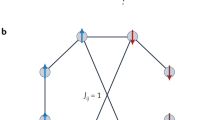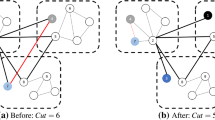Abstract
The recent emergence of novel computational devices, such as adiabatic quantum computers, CMOS annealers, and optical parametric oscillators, present new opportunities for hybrid-optimization algorithms that are hardware accelerated by these devices. In this work, we propose the idea of an Ising processing unit as a computational abstraction for reasoning about these emerging devices. The challenges involved in using and benchmarking these devices are presented and commercial mixed integer programming solvers are proposed as a valuable tool for the validation of these disparate hardware platforms. The proposed validation methodology is demonstrated on a D-Wave 2X adiabatic quantum computer, one example of an Ising processing unit. The computational results demonstrate that the D-Wave hardware consistently produces high-quality solutions and suggests that as IPU technology matures it could become a valuable co-processor in hybrid-optimization algorithms.
Access this chapter
Tax calculation will be finalised at checkout
Purchases are for personal use only
Similar content being viewed by others
Notes
- 1.
For MIP solvers, the runtime includes the computation of the optimally certificate.
- 2.
The source code is available at https://github.com/lanl-ansi/ under the repository names bqpjson, dwig and bqpsolvers.
References
Johnson, M.W., et al.: Quantum annealing with manufactured spins. Nature 473(7346), 194–198 (2011)
International Business Machines Corporation: IBM building first universal quantum computers for business and science (2017). https://www-03.ibm.com/press/us/en/pressrelease/51740.wss. Accessed 28 Apr 2017
Mohseni, M., et al.: Commercialize quantum technologies in five years. Nature 543, 171–174 (2017)
Chmielewski, M., et al.: Cloud-based trapped-ion quantum computing. In: APS Meeting Abstracts (2018)
Yamaoka, M., Yoshimura, C., Hayashi, M., Okuyama, T., Aoki, H., Mizuno, H.: 24.3 20k-spin Ising chip for combinational optimization problem with CMOS annealing. In: 2015 IEEE International Solid-State Circuits Conference - (ISSCC) Digest of Technical Papers, pp. 1–3, February 2015
Yoshimura, C., Yamaoka, M., Aoki, H., Mizuno, H.: Spatial computing architecture using randomness of memory cell stability under voltage control. In: 2013 European Conference on Circuit Theory and Design (ECCTD), pp. 1–4, September 2013
Fujitsu: Digital annealer, May 2018. http://www.fujitsu.com/global/digitalannealer/. Accessed 26 Feb 2019
Modha, D.S.: Introducing a brain-inspired computer (2017). http://www.research.ibm.com/articles/brain-chip.shtml. Accessed 28 Apr 2017
Davies, M., et al.: Loihi: a neuromorphic manycore processor with on-chip learning. IEEE Micro 38(1), 82–99 (2018)
Schuman, C.D., et al.: A survey of neuromorphic computing and neural networks in hardware (2017). arXiv preprint: arXiv:1705.06963
Caravelli, F.: Asymptotic behavior of memristive circuits and combinatorial optimization (2017)
Traversa, F.L., Di Ventra, M.: MemComputing integer linear programming (2018)
McMahon, P.L., et al.: A fully-programmable 100-spin coherent Ising machine with all-to-all connections. Science 354, 614–617 (2016). https://doi.org/10.1126/science.aah5178
Inagaki, T., et al.: A coherent Ising machine for 2000-node optimization problems. Science 354(6312), 603–606 (2016)
Kielpinski, D., et al.: Information processing with large-scale optical integrated circuits. In: 2016 IEEE International Conference on Rebooting Computing (ICRC), pp. 1–4, October 2016
Feynman, R.P.: Simulating physics with computers. Int. J. Theor. Phys. 21(6), 467–488 (1982)
Brush, S.G.: History of the lenz-ising model. Rev. Mod. Phys. 39, 883–893 (1967)
D-Wave Systems Inc.: Customers (2017). https://www.dwavesys.com/our-company/customers. Accessed 28 Apr 2017
Haribara, Y., Utsunomiya, S., Yamamoto, Y.: A coherent Ising machine for MAX-CUT problems: performance evaluation against semidefinite programming and simulated annealing. In: Yamamoto, Y., Semba, K. (eds.) Principles and Methods of Quantum Information Technologies. LNP, vol. 911, pp. 251–262. Springer, Tokyo (2016). https://doi.org/10.1007/978-4-431-55756-2_12
Lucas, A.: Ising formulations of many NP problems. Frontiers Phys. 2, 5 (2014)
Bian, Z., Chudak, F., Israel, R.B., Lackey, B., Macready, W.G., Roy, A.: Mapping constrained optimization problems to quantum annealing with application to fault diagnosis. Frontiers ICT 3, 14 (2016)
Bian, Z., Chudak, F., Israel, R., Lackey, B., Macready, W.G., Roy, A.: Discrete optimization using quantum annealing on sparse Ising models. Frontiers Phys. 2, 56 (2014)
Rieffel, E.G., Venturelli, D., O’Gorman, B., Do, M.B., Prystay, E.M., Smelyanskiy, V.N.: A case study in programming a quantum annealer for hard operational planning problems. Quantum Inf. Process. 14(1), 1–36 (2015)
Venturelli, D., Marchand, D.J.J., Rojo, G.: Quantum annealing implementation of job-shop scheduling (2015)
de Givry, S., Larrosa, J., Meseguer, P., Schiex, T.: Solving Max-SAT as weighted CSP. In: Rossi, F. (ed.) CP 2003. LNCS, vol. 2833, pp. 363–376. Springer, Heidelberg (2003). https://doi.org/10.1007/978-3-540-45193-8_25
Morgado, A., Heras, F., Liffiton, M., Planes, J., Marques-Silva, J.: Iterative and core-guided maxsat solving: a survey and assessment. Constraints 18(4), 478–534 (2013)
McGeoch, C.C., Wang, C.: Experimental evaluation of an adiabiatic quantum system for combinatorial optimization. In: Proceedings of the ACM International Conference on Computing Frontiers, CF 2013, pp. 23:1–23:11. ACM (2013)
Nieuwenhuis, R.: The IntSat method for integer linear programming. In: O’Sullivan, B. (ed.) CP 2014. LNCS, vol. 8656, pp. 574–589. Springer, Cham (2014). https://doi.org/10.1007/978-3-319-10428-7_42
Zdeborova, L., Krzakala, F.: Statistical physics of inference: thresholds and algorithms. Adv. Phys. 65(5), 453–552 (2016)
Bian, Z., Chudak, F., Macready, W.G., Rose, G.: The Ising model: teaching an old problem new tricks (2010). https://www.dwavesys.com/sites/default/files/weightedmaxsat_v2.pdf. Accessed 28 Apr 2017
Benedetti, M., Realpe-Gómez, J., Biswas, R., Perdomo-Ortiz, A.: Estimation of effective temperatures in quantum annealers for sampling applications: a case study with possible applications in deep learning. Phys. Rev. A 94, 022308 (2016)
Boixo, S., et al.: Evidence for quantum annealing with more than one hundred qubits. Nat. Phys. 10(3), 218–224 (2014)
Denchev, V.S., et al.: What is the computational value of finite-range tunneling? Phys. Rev. X 6, 031015 (2016)
King, J., Yarkoni, S., Nevisi, M.M., Hilton, J.P., McGeoch, C.C.: Benchmarking a quantum annealing processor with the time-to-target metric (2015). arXiv preprint: arXiv:1508.05087
Boothby, T., King, A.D., Roy, A.: Fast clique minor generation in chimera qubit connectivity graphs. Quantum Inf. Process. 15(1), 495–508 (2016)
Cai, J., Macready, W.G., Roy, A.: A practical heuristic for finding graph minors (2014)
Klymko, C., Sullivan, B.D., Humble, T.S.: Adiabatic quantum programming: minor embedding with hard faults. Quantum Inf. Process. 13(3), 709–729 (2014)
Koch, T., et al.: MIPLIB 2010: mixed integer programming library version 5. Math. Program. Comput. 3(2), 103–163 (2011)
Gent, I.P., Walsh, T.: CSPLib: a benchmark library for constraints. In: Jaffar, J. (ed.) CP 1999. LNCS, vol. 1713, pp. 480–481. Springer, Heidelberg (1999). https://doi.org/10.1007/978-3-540-48085-3_36
Hoos, H.H., Stutzle, T.: SATLIB: An online resource for research on SAT (2000)
Coffrin, C., Nagarajan, H., Bent, R.: Challenges and successes of solving binary quadratic programming benchmarks on the DW2X QPU. Technical report, Los Alamos National Laboratory (LANL) (2016)
Hen, I., Job, J., Albash, T., Rønnow, T.F., Troyer, M., Lidar, D.A.: Probing for quantum speedup in spin-glass problems with planted solutions. Phys. Rev. A 92, 042325 (2015)
King, J., et al.: Quantum annealing amid local ruggedness and global frustration (2017)
Mandrà, S., Zhu, Z., Wang, W., Perdomo-Ortiz, A., Katzgraber, H.G.: Strengths and weaknesses of weak-strong cluster problems: a detailed overview of state-of-the-art classical heuristics versus quantum approaches. Phys. Rev. A 94, 022337 (2016)
Mandrà, S., Katzgraber, H.G., Thomas, C.: The pitfalls of planar spin-glass benchmarks: raising the bar for quantum annealers (again) (2017)
Aaronson, S.: D-wave: Truth finally starts to emerge, May 2013. http://www.scottaaronson.com/blog/?p=1400. Accessed 28 Apr 2017
Aaronson, S.: Insert d-wave post here, March 2017. http://www.scottaaronson.com/blog/?p=3192. Accessed 28 Apr 2017
King, A.D., Lanting, T., Harris, R.: Performance of a quantum annealer on range-limited constraint satisfaction problems (2015). arXiv preprint: arXiv:1502.02098
Kirkpatrick, S., Gelatt, C.D., Vecchi, M.P.: Optimization by simulated annealing. Science 220(4598), 671–680 (1983)
Hamze, F., de Freitas, N.: From fields to trees. In: Proceedings of the 20th Conference on Uncertainty in Artificial Intelligence, UAI 2004, Arlington, Virginia, United States, pp. 243–250. AUAI Press (2004)
Selby, A.: Efficient subgraph-based sampling of Ising-type models with frustration (2014)
Selby, A.: Qubo-chimera (2013). https://github.com/alex1770/QUBO-Chimera
Puget, J.F.: D-wave vs cplex comparison. Part 2: Qubo (2013). https://www.ibm.com/developerworks/community/blogs/jfp/entry/d_wave_vs_cplex_comparison_part_2_qubo. Accessed 28 Nov 2018
Dash, S.: A note on qubo instances defined on chimera graphs (2013). arXiv preprint: arXiv:1306.1202
Billionnet, A., Elloumi, S.: Using a mixed integer quadratic programming solver for the unconstrained quadratic 0-1 problem. Math. Program. 109(1), 55–68 (2007)
Farhi, E., Goldstone, J., Gutmann, S., Sipser, M.: Quantum computation by adiabatic evolution (2018)
Kadowaki, T., Nishimori, H.: Quantum annealing in the transverse Ising model. Phys. Rev. E 58, 5355–5363 (1998)
Farhi, E., Goldstone, J., Gutmann, S., Lapan, J., Lundgren, A., Preda, D.: A quantum adiabatic evolution algorithm applied to random instances of an NP-complete problem. Science 292(5516), 472–475 (2001)
Nightingale, M.P., Umrigar, C.J. (eds.): Quantum Monte Carlo Methods in Physics and Chemistry. Nato Science Series C, vol. 525. Springer, Netherlands (1998)
Parekh, O., Wendt, J., Shulenburger, L., Landahl, A., Moussa, J., Aidun, J.: Benchmarking adiabatic quantum optimization for complex network analysis (2015)
IBM ILOG CPLEX Optimizer. https://www.ibm.com/analytics/cplex-optimizer. Accessed 2010
Gurobi Optimization, Inc.: Gurobi optimizer reference manual (2014). http://www.gurobi.com
D-Wave Systems Inc.: The D-wave 2X quantum computer technology overview (2015). https://www.dwavesys.com/sites/default/files/D-Wave%202X%20Tech%20Collateral_0915F.pdf. Accessed 28 Apr 2017
Vuffray, M., Misra, S., Lokhov, A., Chertkov, M.: Interaction screening: efficient and sample-optimal learning of Ising models. In: Lee, D.D., Sugiyama, M., Luxburg, U.V., Guyon, I., Garnett, R. (eds.) Advances in Neural Information Processing Systems, vol. 29, pp. 2595–2603. Curran Associates, Inc. (2016)
Lokhov, A.Y., Vuffray, M., Misra, S., Chertkov, M.: Optimal structure and parameter learning of Ising models (2016)
Mitchell, D., Selman, B., Levesque, H.: Hard and easy distributions of sat problems. In: Proceedings of the Tenth National Conference on Artificial Intelligence, AAAI 1992, pp. 459–465. AAAI Press (1992)
Balyo, T., Heule, M.J.H., Jarvisalo, M.: Sat competition 2016: recent developments. In: Proceedings of the Thirty-First National Conference on Artificial Intelligence, AAAI 2017, pp. 5061–5063. AAAI Press (2017)
Author information
Authors and Affiliations
Corresponding author
Editor information
Editors and Affiliations
Rights and permissions
Copyright information
© 2019 Springer Nature Switzerland AG
About this paper
Cite this paper
Coffrin, C., Nagarajan, H., Bent, R. (2019). Evaluating Ising Processing Units with Integer Programming. In: Rousseau, LM., Stergiou, K. (eds) Integration of Constraint Programming, Artificial Intelligence, and Operations Research. CPAIOR 2019. Lecture Notes in Computer Science(), vol 11494. Springer, Cham. https://doi.org/10.1007/978-3-030-19212-9_11
Download citation
DOI: https://doi.org/10.1007/978-3-030-19212-9_11
Published:
Publisher Name: Springer, Cham
Print ISBN: 978-3-030-19211-2
Online ISBN: 978-3-030-19212-9
eBook Packages: Computer ScienceComputer Science (R0)




